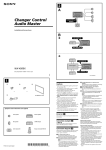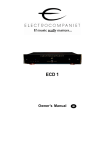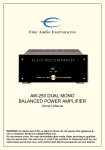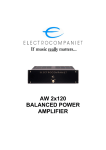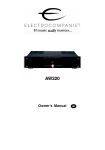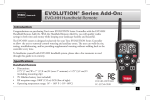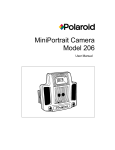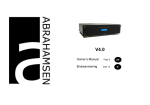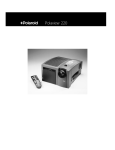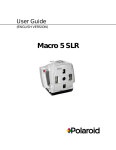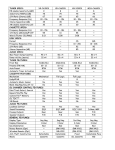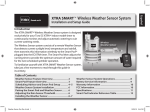Download ECP1 MC / MM PHONO PREAMPLIFIER OWNERS MANUAL
Transcript
ECP1 MC / MM PHONO PREAMPLIFIER OWNERS MANUAL WARNING: To reduce risk of fire or electric shock, do not expose this appliance to rain or moisture. Do not remove cover. No user serviceable parts inside. Refer to qualified service personell. Thank you for selecting Electrocompaniet We sincerely thank you for selecting an amplifier from Electrocompaniet. We hope you will enjoy years of listening pleasure and true high-end musical performance with your audio system. Kindly read this owners manual in order to familiarize you with the set before operation. The Electrocompaniet Story Electrocompaniet was founded in 1973 in Oslo, Norway, to manufacture an amplifier designed By Per Abrahamsen. The designs were based upon a new approach to transistor amplifier design developed by Dr. Matti Otala and Jan Lohstro. It had long been recognized that transistor amplifiers had a characteristic sound that many audiophiles and music lovers found unnatural. Dr. Otala and Mr. Lohstro analyzed transistor amplifiers to determine what actually created the "transistor sound" in general transistorized designs. The results of their innovative design work were incorporated into the first Electrocompaniet design, the legendary 25-watt amplifier. This product were the first commercial transistor amplifier to use this new design approach, and the amplifier was immediately recognized as dramatically more musical sounding than any other transistor amplifier. The same design philosophy, which has been constantly updated through additional research and experience, is the basis for all the current Electrocompaniet Ampliwire and Preampliwire Dual Mono Balanced designs. Electrocompaniet have always given extensive listening test of all its designs the highest priority. Every product designed by our engineers must meet the varied and exacting standards of the listening panel, carefully selected to represent a cross section of musical taste and experience. Electrocompaniet designs go back and forth between the design laboratory and the listening panel until both engineers and listeners are completely satisfied, and ensured that the design has met its technical and sonically objectives. All Electrocompaniet products are handmade by highly skilled technicians, and extensively tested for maximum performance and reliability. Final adjustments are made only after an extended period of operation to insure the best possible performance under conditions similar to actual use. Electrocompaniet Ampliwire and Preampliwire are sold in more than 25 countries, providing the ultimate listening pleasure to dedicated music lovers worldwide. The design features of ECP1 PHONO Preamplifier After the Electrocompaniet 25 waft amplifier had established a new standard for transistor amplifiers, research was undertaken to find ways to make the amplifier even better, and to extend its highly musical sound quality to more powerful amplifier designs. Only reducing the commonly recognized types of distortion to low levels did not satisfy the engineers of Electrocompaniet. They recognized that distortion appears in many forms, and that distortion was still audible in listening tests even when conventional categories of distortion were at vanishing low levels. Traditionally, designers increased feedback to make a larger portion of the output signal control the amplifiers response. Our listening tests showed us that simply applying more feedback was not the answer. In fact, as one kind of distortion went down, other parameters would be adversely affected, leading to an overall degradation of sound quality. We knew that the other conventional design approach of eliminating feedback completely was not the answer either, because this would cause high distortion levels, and as a result "wooly" sound. The answer to the dilemma was found in a novel approach to feedback theory. We developed a feedback concept that allowed local feedback to be applied around individual stages of the amplifier circuit. This approach allowed us to avoid the sonic disadvantages of overall feedback from output to input. The concept was further developed to reduce phase and interphase distortion between stages of the amplifier as well. We were able to concentrate the loop feedback on the stages of the amplifier where it resulted in audible improvement. Stability margins were also expanded because feedback no longer affected the frequency response. The use of this concept of individual gain blocks - complex in design but simple in function - allowed us to reduce distortion to minute values in all the products. Unpacking the preamplifier: Immediately upon receipt of the preamplifier, inspect the carton for possible damage during shipment. If the carton is visibly damaged, a claim must be filed with the carrier as soon as possible. Unpack the unit carefully, and please do remember to save all packaging materials for future shipment. The carton and packaging have been designed to offer the safest possible protection when transporting your amplifier, for the prevention of damage to the unit. The content of the carton is as follows: 1 pc ECP1 Phono Preamplifier 1 pcs Electrocompaniet AC adapter 1 pcs Owners Manual Connecting ECP1 Phono preamplifier Connecting to mains Check that the mains voltage printed on the AC adapter corresponds with the line voltage in the territory were you intend to connect your preamplifier. The rear panel The rear panel of the ECP1 contains all input- and output connectors. The printed rear panel clearly indicates the function of each connector. How to avoid noise problems The ECP1 preamplifier contains circuitry that might be sensitive to magnetic fields. The set should be placed well away from transformers, etc. Care should also be taken in routing all signal cables. They should not run parallel to speaker cables or AC cables mains). Keep cables as short as possible. For minimum hum, the preamplifier should be places on the right side of the power amplifier because of the location of the MC circuitry). If placed above a power amplifier, leave at least 4" 110 cm) of space between the top of the amplifier and bottom of the preamplifier. How to avoid damages A good operating practice is to turn off all equipment before any connection or disconnection are made. Do not under any circumstances connect or disconnect equipment when power is turned on. If you insist on connecting or disconnecting while power is turned on, you should be aware that the design of the RCA plug generates a large transient when inserting the plug. This could damage both the speakers and the amplifier. Switches The MC/MM switch is located at the rear of the unit, and LED in the frontpanel indicate the selected type of cartridge. ALWAYS turn the volume control all the way down before changing from MM/MC or MC/MM. Warning: The preamplifier will be warm. Due to the high class A operating point used in the Electrocompaniet design, it is normal that the preamplifier feels warm. Proper ventilation will be needed, and the preamplifier should not be covered up. A good rule is to allow 1 - 2 inches of space sidewise, and 2 - 3 inches above the preamplifier. Service Policy: If service is needed Your dealer will have all relevant information about the service centers in your area, and will ensure that your unit is serviced without delay. It is our general policy to have your preamplifier returned to you within 5 working days. This is an average time, and could vary locally, depending on the workload at the service center. If, for some reason, there are no service facilities available in your country, please ship the preamplifier to the following adress: ELECTROCOMPANIET A/S SOLHEIMVEIEN 36 N-1473 SKÅRER NORWAY FAX + 47 67911760 You are responsible for all shipping charges, insurance, re-importation to your country, and duty arrangements. When shipping a product to the factory for service, always include the following: 1) A sales slip or other proof of purchase if repair is claimed under warranty. 2) A proforma invoice with value of the goods, stating that the preamplifier is returned to Norway for repair. 3) An accompanying letter describing faults, symptoms, or problems with the preamplifier. 3) Always ship the preamplifier in its original carton and packaging material to prevent damage in transit. Electrocompaniet will not cover damages incurred in transit. If you require further information concerning the preamplifier operation, or if you have any questions related to service, please do not hesitate to contact your dealer or national Electrocompaniet let distributor. Technical Specifications: ECP1 The following technical data were measured on randomized test objects and were typical data. All measurements are made with the following equipment: Distortion analyzer: Tektronix M50 1 Oscilloscope: Tektronix 468 Oscillator: Tektronix 5G505 Frequency counter: Rascal 9838 Phase meter: Hewlett Packard 3575A Phono stage Phono input to record output Gain 1 KHz Moving Coil (source impedance = 10 ohm) Gain 1 KHz Moving Magnet Input Impedance Moving Magnet THD 1 KHz (2V output) Overload 1 KHz Moving Coil (THD = 0,2%) Overload 1 KHz Moving Magnet )THD = 0,2%) Channel separation )iV output at 1 KHz) Noise ref. 0,5 mV) Moving Coil Noise (ref. 5 mV) Moving Magnet Equivalent input noise 400 Hz - 300 KHz) RIM Accuracy (20 Hz - 20 KHz) Output impedance Dimensions 73 dB (4500x) 34.8 dB (55x) 47 Kohm/22pF less than 0.007% more than 2 mV more than 165mV more than 80dB -88 dB -88 dB 0,2 uV +/-0,1 dB 100 ohm Width 240mm (9.5 inches) Depth 165 mm (6.5 inches) Height 65 mm (2.5 inches) Weight 2.2 kg (4.4lbs) The manufacturer reserves the right to alter these specifications without further notice.






